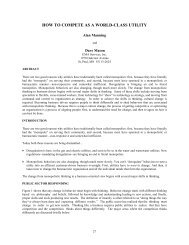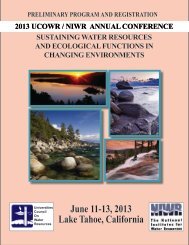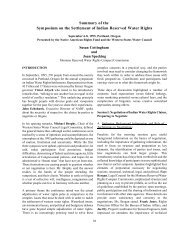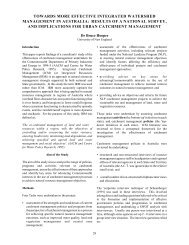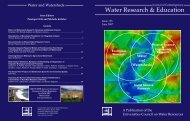Full Journal of Contemporary Water Research and Education, Issue ...
Full Journal of Contemporary Water Research and Education, Issue ...
Full Journal of Contemporary Water Research and Education, Issue ...
Create successful ePaper yourself
Turn your PDF publications into a flip-book with our unique Google optimized e-Paper software.
122McKayState Implementation <strong>of</strong> the NWI throughRegional OrganizationsRegional delivery <strong>of</strong> natural resourcesmanagement is the principle mode <strong>of</strong> investmentunder the Natural Heritage Trust <strong>and</strong> National ActionPlan for salinity <strong>and</strong> the particular role <strong>of</strong> DEHthrough its leadership <strong>of</strong> the Natural Heritage Trustsecond Phase. Each State needs to create new regionalNatural Resources Management structures.Such bodies should include l<strong>and</strong>owners, industries,non-government organizations, indigenousrepresentatives, representatives from the three levels<strong>of</strong> government (local, state, <strong>and</strong> national) <strong>and</strong>other interested people. This is the way for local<strong>and</strong> other parties to be involved in natural resourcesmanagement (Australian Local GovernmentAssociation 2005). Australia has been divided into60 regions with each one responsible for preparinga regional natural resources management plan.The structure <strong>and</strong> nomenclature varies between<strong>and</strong> within the states based on variations in statelegislation (Mutton pers. com. 2006 SA). Theselection processes for members <strong>of</strong> the regionalbodies differ as well. The final aspect <strong>of</strong> differenceis where the state overarching body is placed inthe existing state natural resources managementprocesses. The case study from South Australiasets out the process in a well advanced state. Therole <strong>of</strong> the Natural Resources Management Councilin South Australia under the Natural ResourcesManagement Act 2004 is to draft a State Plan fornatural resources management <strong>and</strong> to take responsibilityto deliver the National Action Plan <strong>and</strong>Natural Heritage Trust bilateral Agreements signedwith the Federal Government. The State Plan is for5 years <strong>and</strong> was completed in 2005 with a 50-yearvision. The Plan informs government agencies,the eight regional Natural Resources ManagementBoards, local government, community <strong>and</strong> industrypartners (Eyre Peninsula Coastal DevelopmentStrategy 2006). Each Regional Natural ResourcesManagement Board drafts their own Regional Planinvolving all <strong>of</strong> the above with support from StateAgencies. Each Regional Plan highlights all thenatural resources management issues in the region,develops actions to address these concerns <strong>and</strong> thenselects the most important issues for action. Theplans also set resource conditions <strong>and</strong> managementaction targets based on agreed national st<strong>and</strong>ardsto help determine progress toward achieving outcomes.State-Based Definitions <strong>of</strong> EnvironmentallySustainable Development <strong>and</strong> NaturalResources Management: PotentialPartnership Problems for <strong>Water</strong> SupplyBusinessesWhile the overarching goals are set federally, themeans to achieve them are left to the states who,as in all federations, chose to do things differently.This can create a laboratory <strong>of</strong> policy experimentsthat <strong>of</strong>fer learning opportunities, but can also createconfusion (Br<strong>and</strong>ies 1932). What does sustainabledevelopment really mean? Sustainable developmentas a concept is notable for the lack <strong>of</strong> consistencyin its interpretation (Sharachch<strong>and</strong>ra 1991). Whileits breadth is appealing on the political level, thisis also its weakness as the problems <strong>of</strong> poverty,environmental degradation, economic growth, <strong>and</strong>participation are not well articulated. Such a lack<strong>of</strong> clarity may hamper the debate <strong>and</strong> certainly theimplementation.In Australia, each state has definedEnvironmentally Sustainable Development ina number <strong>of</strong> acts that apply to all actions <strong>of</strong> thewater supply businesses <strong>and</strong> other institutions.The definitions <strong>of</strong> each <strong>of</strong> these spans over manysections <strong>of</strong> each <strong>of</strong> the Acts <strong>and</strong> the rules <strong>and</strong>interpretation <strong>of</strong> Acts in each state are alsodifferent. The modern concept <strong>of</strong> EnvironmentallySustainable Development, which in someinstances date from only 1987 (Brundtl<strong>and</strong> 1987),differs in its width within each state (Table 1).The fundamental premise <strong>of</strong> EnvironmentallySustainable Development (ESD) is that economicdevelopment must be balanced against theprotection <strong>of</strong> biological diversity, the promotion<strong>of</strong> equity within <strong>and</strong> between generations, <strong>and</strong> themaintenance <strong>of</strong> essential ecological processes. TheCommonwealth Government working groups onESD drafted these principles as a guide in 1992(Hamilton <strong>and</strong> Throsby 1998) to facilitate decisionmakingprocesses to effectively integrate both long<strong>and</strong> short-term economic, environmental, social,<strong>and</strong> equity considerations.1. Lack <strong>of</strong> full scientific certainty should notbe used as a reason for postponing measuresto prevent environmental degradation (theUCOWRJOURNAL OF CONTEMPORARY WATER RESEARCH & EDUCATION



